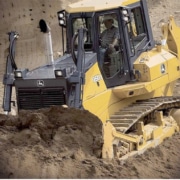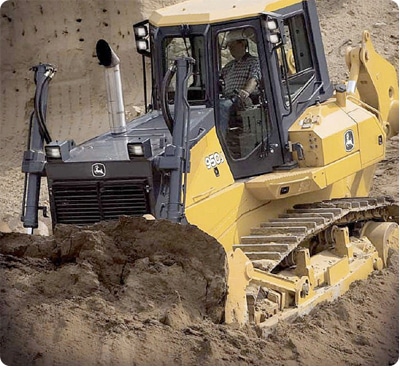Getting the General Feel of Maneuvering a Catamaran
Some have compared maneuvering a cat with driving a bulldozer. Well . . . perhaps!
Chances are, you have not driven a real bulldozer but you do remember your childhood sandbox. The tracks on each side of the bulldozer move independently to allow the bulldozer to do some amazing maneuvering. A Catamaran has the same ability. The two propellers on the Catamaran are mounted at the aft end of each hull, placing the thrust forces far apart. This greatly enhances the turning moment. The throttles on the two engines, therefore, have the same maneuvering effect as the levers on a bulldozer. Push one forward and the other in reverse and the Cat will spin on itself.
If you can imagine a bulldozer when you push the left track lever forward and the right track lever backward, which way does the bulldozer spin? Clockwise right? The left track goes forward and the right track goes back; this acts to turn the bulldozer clockwise.
- Both tracks forward—bulldozer goes forward.
- Both tracks back—bulldozer goes backward.
- Left track back and right track forward—bulldozer turns counterclockwise.
- Right track back and left track forward—bulldozer turns clockwise.
And bulldozers are cool because they can turn inside their own length.
Rule of Thumb
If you’ve not driven a bulldozer or the like, no worries! Just remember that the cat turns by a rule of thumb. That is … the cat turns in the direction of your thumb on the throttle that you have engaged in forward.
See this
With the wheel locked in the center, try this:
- Both throttles forward—cat goes forward.
- Both throttles back—the cat goes backward.
- Left throttle back and right throttle forward—cat spins counterclockwise.
- Right throttle back and left throttle forward—cat spins clockwise
- Left throttle back a little and right throttle forward full—slow forward turn counterclockwise.
- Right throttle back a little and left throttle forwards full—slow forward turn clockwise.
Play with the animation below by clicking on the arrows. Note that for broad turning, the reverse throttle is not all the way back.
As ridiculous as it seems, we want you to get into your favorite armchair right now, clench each of your fists around a screwdriver or chopstick, and practice moving those bulldozer levers alternately left-back/right-forward and vice versa. (Feel free to make brrrmmm brrrmmm noises). Come on do it – this is building muscle memory. You’ll intuitively feel which way the bulldozer will turn. Do it a couple of dozen times and you’ve probably got enough skill to get you out of the marina—well, maybe not.
Notice that at this stage we have not talked about the wheel/rudders. You can perform the maneuvers in the above animation with the wheel locked in its center position.
Momentum
Become confident in how quickly or slowly the boat will stop. You’ll notice that the forward momentum of the boat is hard to quell with the engines. This is because the propellers are set up to be efficient in forward thrust, but not in reverse thrust. Thus, a significant understanding of killing off boat momentum should be practiced—away from anything. You’ll be surprised how long it takes some of these boats to stop. No problem, however; you’re gaining the feel with all the exercises above. In reverse, the story is different. Reverse momentum, as with a monohull, can be killed off quickly with just a little (efficient) forward thrust.
Practicing is important – not just for embarrassing reasons but for your credit card deposit or insurance deductible reasons. Collisions in boats this expensive are just not necessary when you’ve spent a little time practicing and gaining an appreciation of the maneuverability of the boat.
 Exercise M10-1
Exercise M10-1
Practice all the monohull examples given in this book on your cat once you’re out of the marina, clear of everyone, clear of sight of the charter company, and before you set the sails.
- With the boat moving forward, put the boat in reverse and try to stop it
- With the boat moving in reverse, put the boat in forward and try to stop in
- Spin the boat clockwise
- Spin the boat counterclockwise
- Do figure 8’s in forward and reverse
- Engage just one throttle in forward and see what the boat does – add a little opposite reverse
- Engage just one throttle in reverse and see what the boat does – add a little opposite forward thrust.
- Try various combinations of forward and reverse thrust
 What You Learned
What You Learned
As with the monohull exercises, you’re getting the hang of the boat for its turning capacity, momentum, and reversing ability.
There is a temptation to forget about the rudders when maneuvering because the engines are extremely effective. In the next section, you’ll see the added dimension of the rudders and what they can do to assist.




 Exercise M10-1
Exercise M10-1 What You Learned
What You Learned



